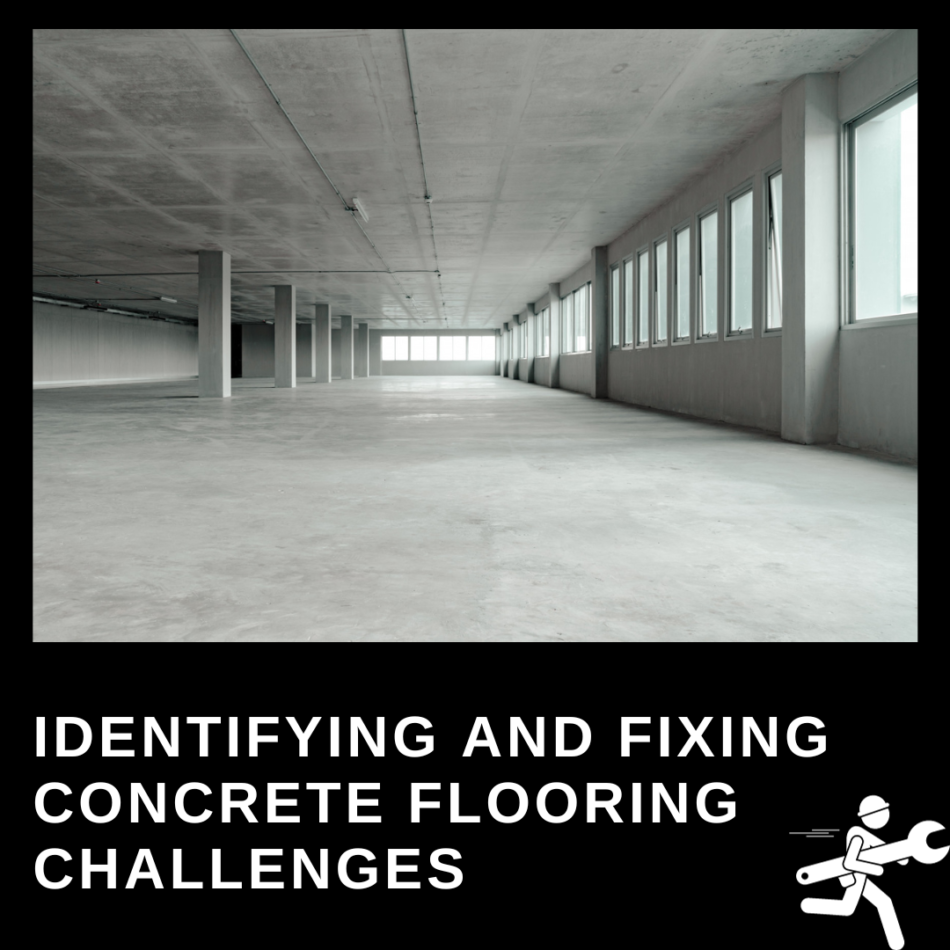Concrete flooring is widely praised for its durability, eco-friendliness, and low maintenance. However, like any material, it can encounter challenges that affect its aesthetics and functionality. In this article, we’ll explore common concrete flooring problems, how to identify them, and the best ways to address and fix them.
1. Cracking
Identification: The most common and easily recognizable challenge with concrete floors is cracking. These can range from hairline cracks to larger, more conspicuous ones.
Fix: Hairline cracks might not need repair for structural reasons, but can be sealed for aesthetic purposes. Larger cracks, however, might require filling with a concrete patching compound. Ensure that the underlying cause, such as soil movement or heavy loads, is addressed to prevent recurrence.
“Cracks in the concrete remind us that no matter how strong we think we are, time and nature always have their way, teaching us resilience and the beauty of imperfection.”
2. Efflorescence
Identification: This is a white powdery substance that can appear on the surface of concrete floors. It’s caused by water moving through the concrete and carrying soluble salts to the surface.
Fix: Clean the surface with a stiff brush and water, followed by sealing the concrete to prevent moisture infiltration. Addressing water leakage issues is also essential.
3. Dusting
Identification: Dusting presents as a powdery layer on the surface of the concrete floor. It results from a weak concrete surface, often caused by rapid drying, poor curing, or an inadequate mixture.
Fix: Using a concrete sealer can help reduce the progression of dusting. For severe cases, resurfacing might be required.
4. Spalling or Pitting
Identification: This refers to the flaking or chipping off of the concrete’s surface. It can be caused by freeze-thaw cycles, exposure to de-icing salts, or a weak surface mix.
Fix: Remove loose concrete, clean the area, and fill with a patching compound. Resurfacing might be necessary in extreme cases.
5. Discoloration
Identification: Concrete can have uneven colors or shades, often due to variations in mix, curing time, or moisture content during the curing process.
Fix: A chemical stain or dye can be used to restore the uniform color. In some cases, applying a sealer or paint might be necessary.
6. Curling
Identification: This is when the concrete floor’s corners or edges lift due to differences in moisture or temperature between the top and bottom surfaces.
Fix: Grinding the affected areas can help level the surface. For severe cases, slab jacking (injecting a material under the slab to lift it) or replacing the section might be needed.
7. Delamination
Identification: This occurs when the top layer of the concrete separates from the underlying layer. It can be caused by overworking the surface or an excess of water in the mix.
Fix: Unfortunately, delaminated areas often require removal and replacement.
Conclusion
Concrete flooring, though robust and reliable, is not without its challenges. Regular inspection can help in early identification, and prompt action can prevent minor issues from escalating. Whether you’re a homeowner or a construction professional, understanding these common problems will ensure that your concrete flooring remains as impressive as the day it was poured. Remember, the key to long-lasting concrete is not just quality installation but also vigilant care and timely repairs.
1. What are the common challenges faced by concrete floors?
- Concrete floors can face several challenges such as cracking, efflorescence, dusting, spalling, discoloration, curling, and delamination.
2. How can I identify cracks in my concrete floor?
- Cracks can range from hairline fractures to larger, more evident ones. Regular inspection and walking over the surface can help in spotting them.
3. What causes a white powdery substance on my concrete floor?
- The white powdery substance is called efflorescence, caused by water moving through the concrete and bringing soluble salts to the surface.
4. My concrete floor is chipping off. What could be the reason?
- The chipping or flaking off of the concrete’s surface is known as spalling or pitting. It can result from freeze-thaw cycles, exposure to de-icing salts, or a weak surface mix.
5. Why does my concrete floor have uneven colors or shades?
- Discoloration can be due to variations in the concrete mix, differences in curing time, or uneven moisture content during the curing process.
6. What is meant by “curling” in concrete floors?
- Curling refers to the lifting of the concrete floor’s corners or edges due to varying moisture or temperature between the top and bottom surfaces.
7. What action should I take if the top layer of my concrete separates from the underlying layer?
- This issue is called delamination. Unfortunately, areas that have delaminated often require removal and replacement.
8. Is sealing the concrete always a solution for these challenges?
- While sealing can help with issues like efflorescence and dusting by reducing moisture infiltration, it’s not a universal solution. Each challenge has its specific remedy.
9. How can I prevent concrete flooring problems in the future?
- Ensure quality installation, follow proper curing procedures, protect the floor from harsh chemicals, and conduct regular inspections to identify potential problems early on.
10. Are there professional services I can hire to fix concrete flooring problems?
- Yes, there are professionals who specialize in concrete repair and resurfacing. It’s often recommended to consult with them for severe or recurring issues.






